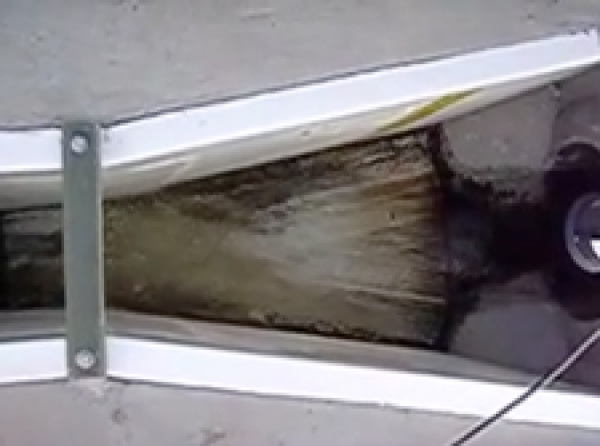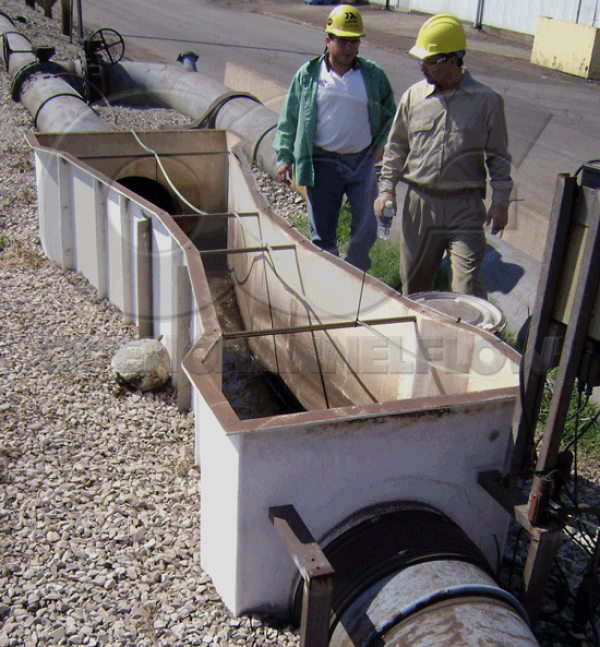This website uses a variety of cookies, which you consent to if you continue to use this site. You can read our Privacy Policy for
details about how these cookies are used, and to grant or withdraw your consent for certain types of cookies.
New Parshall Flume Inlet End Adapters
The traditional method of connecting Parshall flumes to piping has been through the use of end adapters. On the inlet side, the purpose of an end adapter is to expand the flow from the pipe into a channel wider than the entrance of the flume and then contract flow in a controlled way. On the outlet side, the end adapter serves to channel flow out of the flume and back into the pipe.
In addition to horizontally expanding and then contracting the flow from the pipe into the flume, an inlet end adapter also sets the crest (floor) of the flume above the invert of the inlet pipe. Flow exits the inlet pipe and then rises up to enter the flume.
Unfortunately, industry-wide the end adapters currently offered by Parshall flume manufacutrers take a number of short cuts in bringing flow into their Parshall flumes. Flow is contracted horizontally with sharp angled, flat sidewalls and vertically directed into the flume either abruptly (with no transition) or at an angle that exceeds that recommended for flow entering a Parshall flume elevated above a channel. Both of these short cuts can lead to increase error in a flume's accuracy.
The Problem with Flat, Vertical Side Walls
As studies by Blaisdell have shown, when flat, vertical wing walls are used to transition flow into a Parshall flume, a standing wave can develop where the wing wall and the flume entrance meet. As flows increase, the wave moves into the flume, towards the point of measurement.
In an end adapter using similar flat, vertical walls a similar wave / trough pattern can occur. The wave / trough phenomena can be even more pronounced in an inlet end adapter as the angles of contracting in the inlet end adapter typically are greater than 45 degrees.
Sharp Rises into the Flume
In his investigations, Dr. Parshall settled on a 1:4 slope to transition flow into a Parshall flume that is set above a channel’s floor. In a similar way, inlet end adapters have a rise to them to provide a receiving body of water into which the energy of transition from the inlet pipe into a rectangular channel (the end adapter) can be dissipated.
The problem with the current generation of end adapters is that in order to reduce the lay length of the inlet end adapter, the slope of the transition into the flume exceeds the 1:4 slope recommended by Dr. Parshall. The result is that the turbulence dampening properties of the rise in the inlet end adapter are not maximized.
A New Approach
Recognizing these two problems, Openchannelflow has taken a fresh look at the design of inlet end adapters. The result of this investigation is a completely new take on how to transition flows from round pipes into the rectangular cross-section of the Parshall flume.

First an analysis was performed to determine the range of sizes of pipe stubs / caulking collars / flanges that each Parshall flume needs to accommodate. This in turn dictated the depth and, to a degree, the width of the end adapter.
With the depth know, the next step was to correct the rise into the Parshall flume – flattening out the rise so that it met the 1:4 slope requirement. This change extended the length of the inlet end adapter – in some cases by 30% or more, but as accurate flow measurement was the primary concern, the change was viewed as evolutionary.
The new gradual rise into the flume is in stark contrast to some inlet end adapters that had no rise through them at all. There flow comes in horizontally and then has to roll over a 90 degree lip and into the flume - creating considerable turbulence as flows increase.
With the length and depth of the inlet end adapter set, attention was then turned towards determining the plan view shape of the end adapter. Blaisdell had already shown that radius wing walls eliminated the standing wave / trough phenomena common in many channel installed Parshall flumes. The radii prescribed by Dr. Parshall were applied to the inlet end adapter to finish the configuration.
What has resulted is a Parshall flume inlet end adapter that is longer, has a more gradual rise into the flume, and has long parallel sidewalls that smoothly transition the flow into the flume. These changes serve to provide optimal conditions for accurate flow measurement.
Source: Blaisdell, F., Results of Parshall Flume Test, Journal of Irrigation and Drainage Engineering, Vol. 120, No. 2, March / April 1994
Related Blog Posts
Explore more insights in our blog.

LOCATIONS IN ATLANTA, GA & BOISE, ID




